语用学级期末复习思考题教学教材
- 格式:doc
- 大小:98.50 KB
- 文档页数:16
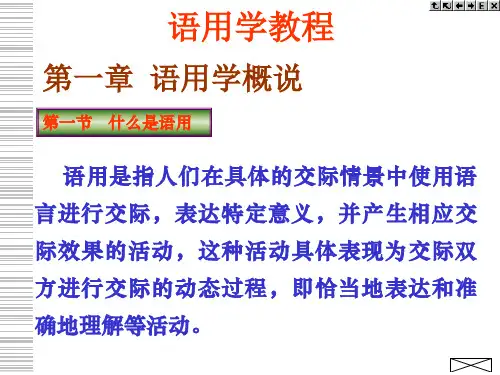
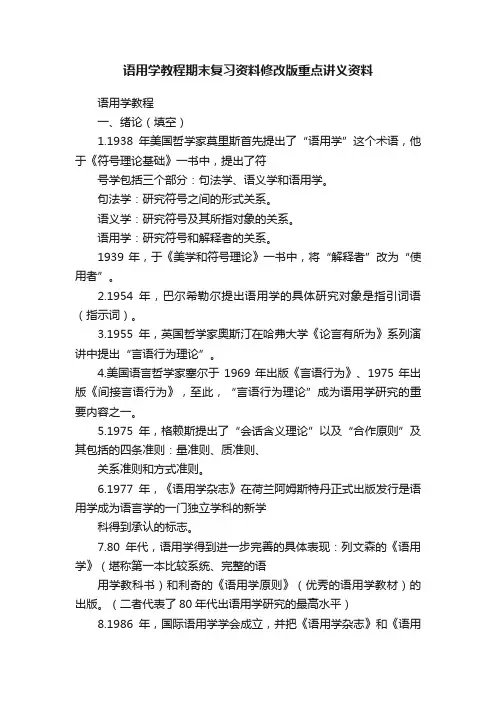
语用学教程期末复习资料修改版重点讲义资料语用学教程一、绪论(填空)1.1938年美国哲学家莫里斯首先提出了“语用学”这个术语,他于《符号理论基础》一书中,提出了符号学包括三个部分:句法学、语义学和语用学。
句法学:研究符号之间的形式关系。
语义学:研究符号及其所指对象的关系。
语用学:研究符号和解释者的关系。
1939年,于《美学和符号理论》一书中,将“解释者”改为“使用者”。
2.1954年,巴尔希勒尔提出语用学的具体研究对象是指引词语(指示词)。
3.1955年,英国哲学家奥斯汀在哈弗大学《论言有所为》系列演讲中提出“言语行为理论”。
4.美国语言哲学家塞尔于1969年出版《言语行为》、1975年出版《间接言语行为》,至此,“言语行为理论”成为语用学研究的重要内容之一。
5.1975年,格赖斯提出了“会话含义理论”以及“合作原则”及其包括的四条准则:量准则、质准则、关系准则和方式准则。
6.1977年,《语用学杂志》在荷兰阿姆斯特丹正式出版发行是语用学成为语言学的一门独立学科的新学科得到承认的标志。
7.80年代,语用学得到进一步完善的具体表现:列文森的《语用学》(堪称第一本比较系统、完整的语用学教科书)和利奇的《语用学原则》(优秀的语用学教材)的出版。
(二者代表了80年代出语用学研究的最高水平)8.1986年,国际语用学学会成立,并把《语用学杂志》和《语用学和其他学科》作为学会的学术刊物。
9.1987年,列文森提出“新格莱斯会话含义理论”。
10.现代语言学的奠基人是索绪尔(区分语言和言语、区分内部要素和外部要素、区分共时状态和历时演变)。
索绪尔的语言和言语理论开创了20世纪的语言学。
结构主义语言学的几个主要学派:哥本哈根学派、布拉格学派、美国描写语言学派、乔姆斯基的转换生成语法理论,使语言分析高度形式化。
11.1966年在波兰召开“国际语义学讨论会”。
12.从结构主义到转换生成语法,存在两大明显的缺陷:忽视语言运用研究。
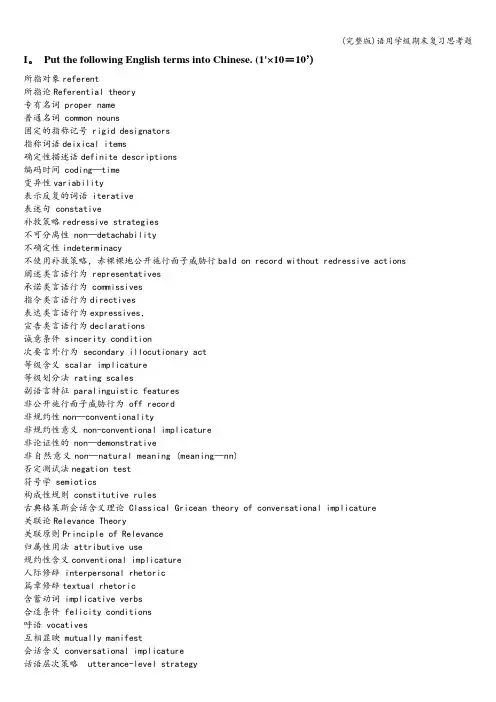
I。
Put the following English terms into Chinese. (1'×10=10’)所指对象referent所指论Referential theory专有名词 proper name普通名词 common nouns固定的指称记号 rigid designators指称词语deixical items确定性描述语definite descriptions编码时间 coding—time变异性variability表示反复的词语 iterative表述句 constative补救策略redressive strategies不可分离性 non—detachability不确定性indeterminacy不使用补救策略,赤裸裸地公开施行面子威胁行bald on record without redressive actions 阐述类言语行为 representatives承诺类言语行为 commissives指令类言语行为directives表达类言语行为expressives,宣告类言语行为declarations诚意条件 sincerity condition次要言外行为 secondary illocutionary act等级含义 scalar implicature等级划分法 rating scales副语言特征 paralinguistic features非公开施行面子威胁行为 off record非规约性non—conventionality非规约性意义 non-conventional implicature非论证性的 non—demonstrative非自然意义non—natural meaning (meaning—nn)否定测试法negation test符号学 semiotics构成性规则 constitutive rules古典格莱斯会话含义理论 Classical Gricean theory of conversational implicature关联论Relevance Theory关联原则Principle of Relevance归属性用法 attributive use规约性含义conventional implicature人际修辞 interpersonal rhetoric篇章修辞textual rhetoric含蓄动词 implicative verbs合适条件 felicity conditions呼语 vocatives互相显映 mutually manifest会话含义 conversational implicature话语层次策略 utterance-level strategy积极面子positive face间接言语行为 indirect speech acts间接指令 indirect directives结语 upshots交际意图communicative intention可撤销性 cancellability可废弃性 defeasibility可推导性 calculability跨文化语用失误cross—cultural pragmatic failure跨文化语用学cross—cultural pragmatics命题内容条件 propositional content condition面子保全论 Face-saving Theory面子论 Face Theory面子威胁行为 Face Threatening Acts (FTAs)蔑视 flouting明示 ostensive明示-推理模式ostensive—inferential model摹状词理论Descriptions粘合程度 scale of cohesion篇章指示 discourse deixis前提 presupposition前提语 presupposition trigger强加的绝对级别absolute ranking of imposition确定谈话目的 establishing the purpose of the interaction确定言语事件的性质 establishing the nature of the speech event 确定性描述语 definite descriptions认知语用学 cognitive pragmatics上下文 co—text社会语用迁移sociopragmatic transfer社交语用失误 sociopragmatic failure施为句 performative省力原则 the principle of least effort实情动词 factive verbs适从向 direction of fit手势型用法 gestural usage首要言外行为 primary illocutionary act双重或数重语义模糊 pragmatic bivalence/ plurivalence顺应的动态性 dynamics of adaptability顺应性adaptability语境关系的顺应(contextual correlates of adaptability)、语言结构的顺应(structural objects of adaptability)、顺应的动态性(dynamics of adaptability)和顺应过程的意识程度(salience of the adaptation processes)。
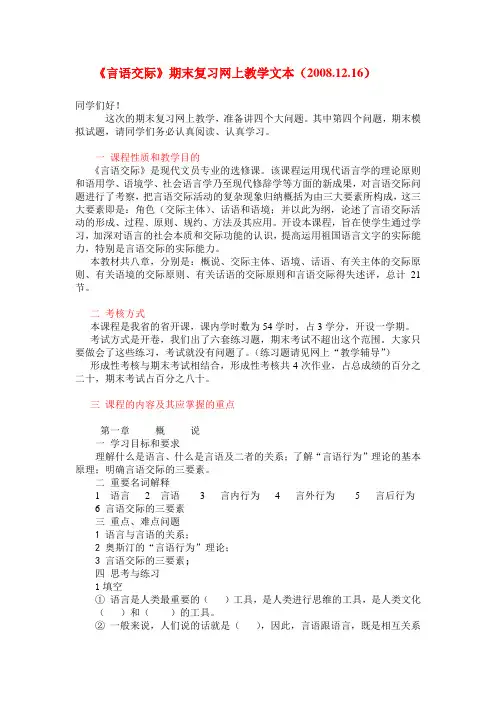
《言语交际》期末复习网上教学文本(2008.12.16)同学们好!这次的期末复习网上教学,准备讲四个大问题。
其中第四个问题,期末模拟试题,请同学们务必认真阅读、认真学习。
一课程性质和教学目的《言语交际》是现代文员专业的选修课。
该课程运用现代语言学的理论原则和语用学、语境学、社会语言学乃至现代修辞学等方面的新成果,对言语交际问题进行了考察,把言语交际活动的复杂现象归纳概括为由三大要素所构成,这三大要素即是:角色(交际主体)、话语和语境;并以此为纲,论述了言语交际活动的形成、过程、原则、规约、方法及其应用。
开设本课程,旨在使学生通过学习,加深对语言的社会本质和交际功能的认识,提高运用祖国语言文字的实际能力,特别是言语交际的实际能力。
本教材共八章,分别是:概说、交际主体、语境、话语、有关主体的交际原则、有关语境的交际原则、有关话语的交际原则和言语交际得失述评,总计21节。
二考核方式本课程是我省的省开课,课内学时数为54学时,占3学分,开设一学期。
考试方式是开卷,我们出了六套练习题,期末考试不超出这个范围。
大家只要做会了这些练习,考试就没有问题了。
(练习题请见网上“教学辅导”)形成性考核与期末考试相结合,形成性考核共4次作业,占总成绩的百分之二十,期末考试占百分之八十。
三课程的内容及其应掌握的重点第一章概说一学习目标和要求理解什么是语言、什么是言语及二者的关系;了解“言语行为”理论的基本原理;明确言语交际的三要素。
二重要名词解释1 语言2 言语3 言内行为4 言外行为5 言后行为6 言语交际的三要素三重点、难点问题1语言与言语的关系;2 奥斯汀的“言语行为”理论;3 言语交际的三要素;四思考与练习1填空①语言是人类最重要的()工具,是人类进行思维的工具,是人类文化()和()的工具。
②一般来说,人们说的话就是(),因此,言语跟语言,既是相互关系的而又是有()的。
③《普通语言学教程》是现代语言学的奠基者()的最主要的著作。
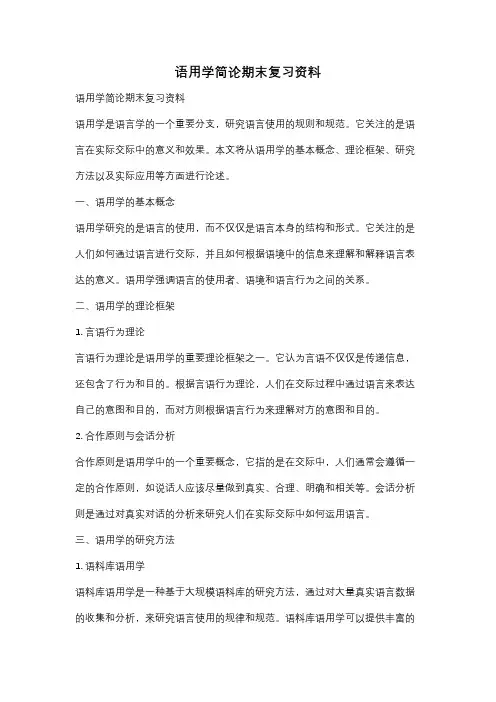
语用学简论期末复习资料语用学简论期末复习资料语用学是语言学的一个重要分支,研究语言使用的规则和规范。
它关注的是语言在实际交际中的意义和效果。
本文将从语用学的基本概念、理论框架、研究方法以及实际应用等方面进行论述。
一、语用学的基本概念语用学研究的是语言的使用,而不仅仅是语言本身的结构和形式。
它关注的是人们如何通过语言进行交际,并且如何根据语境中的信息来理解和解释语言表达的意义。
语用学强调语言的使用者、语境和语言行为之间的关系。
二、语用学的理论框架1. 言语行为理论言语行为理论是语用学的重要理论框架之一。
它认为言语不仅仅是传递信息,还包含了行为和目的。
根据言语行为理论,人们在交际过程中通过语言来表达自己的意图和目的,而对方则根据语言行为来理解对方的意图和目的。
2. 合作原则与会话分析合作原则是语用学中的一个重要概念,它指的是在交际中,人们通常会遵循一定的合作原则,如说话人应该尽量做到真实、合理、明确和相关等。
会话分析则是通过对真实对话的分析来研究人们在实际交际中如何运用语言。
三、语用学的研究方法1. 语料库语用学语料库语用学是一种基于大规模语料库的研究方法,通过对大量真实语言数据的收集和分析,来研究语言使用的规律和规范。
语料库语用学可以提供丰富的实证数据,从而支持语用学的理论研究。
2. 调查问卷和实验研究调查问卷和实验研究是语用学常用的研究方法。
通过设计问卷和实验,研究者可以获取被试者对于语言使用的态度、理解和解释等方面的数据,从而分析语言使用规律。
四、语用学的实际应用1. 跨文化交际语用学的研究成果可以应用于跨文化交际中。
不同的文化背景和价值观会影响人们对语言的理解和使用。
通过了解不同文化中的语用规范和交际习惯,人们可以更好地进行跨文化交际。
2. 社交媒体和网络交际随着社交媒体和网络交际的兴起,语用学在这一领域的应用也越来越重要。
人们在网络上的语言使用往往与实际交际有所不同,语用学可以帮助我们理解网络语言的特点和规律,从而更好地进行网络交际。
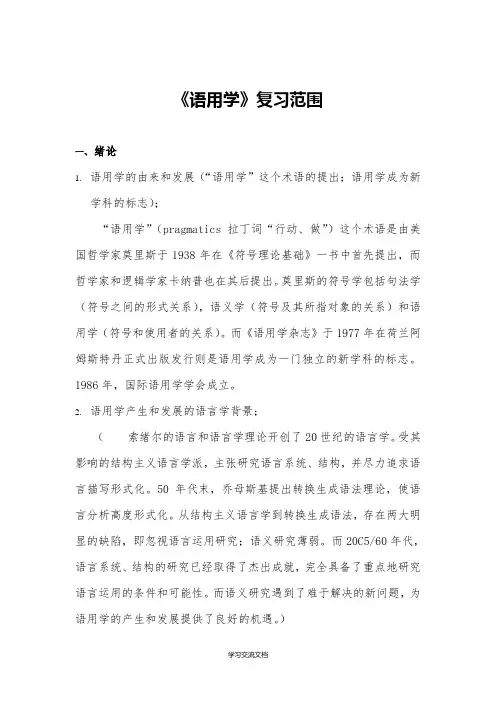
《语用学》复习范围一、绪论1.语用学的由来和发展(“语用学”这个术语的提出;语用学成为新学科的标志);“语用学”(pragmatics拉丁词“行动、做”)这个术语是由美国哲学家莫里斯于1938年在《符号理论基础》一书中首先提出,而哲学家和逻辑学家卡纳普也在其后提出。
莫里斯的符号学包括句法学(符号之间的形式关系),语义学(符号及其所指对象的关系)和语用学(符号和使用者的关系)。
而《语用学杂志》于1977年在荷兰阿姆斯特丹正式出版发行则是语用学成为一门独立的新学科的标志。
1986年,国际语用学学会成立。
2.语用学产生和发展的语言学背景;(索绪尔的语言和语言学理论开创了20世纪的语言学。
受其影响的结构主义语言学派,主张研究语言系统、结构,并尽力追求语言描写形式化。
50年代末,乔母斯基提出转换生成语法理论,使语言分析高度形式化。
从结构主义语言学到转换生成语法,存在两大明显的缺陷,即忽视语言运用研究;语义研究薄弱。
而20C5/60年代,语言系统、结构的研究已经取得了杰出成就,完全具备了重点地研究语言运用的条件和可能性。
而语义研究遇到了难于解决的新问题,为语用学的产生和发展提供了良好的机遇。
)3.语用学的研究内容;语境、指示词语、会话含义、预设、言语行为、会话结构4.语用学和修辞学的区别与联系;●联系:两者的中心问题都是语言运用。
●研究目的不同:修辞学要对语言运用的形式,判别好与不好的界限,注意力是修辞技巧。
而语用学则是解释性的,它的目的是分析语言运用活动,建立意义解释理论,寻找语言运用的规律。
●理论基础不同:修辞学基础薄弱,基本上是一门纯经验的学科,而语用学理论基础雄厚。
●研究方法不同:修辞学主要采纳归纳的方法,而语用学不排斥归纳,但主要方法是理论解释和推理分析。
●研究兴趣和学科传统不同:修辞学以辞格、句子、词语的交际特色、语体风格为具体研究对象;而语用学以语境、指示词语、会话含义等为研究的具体对象。
5.语用学研究的理论意义和实用价值。
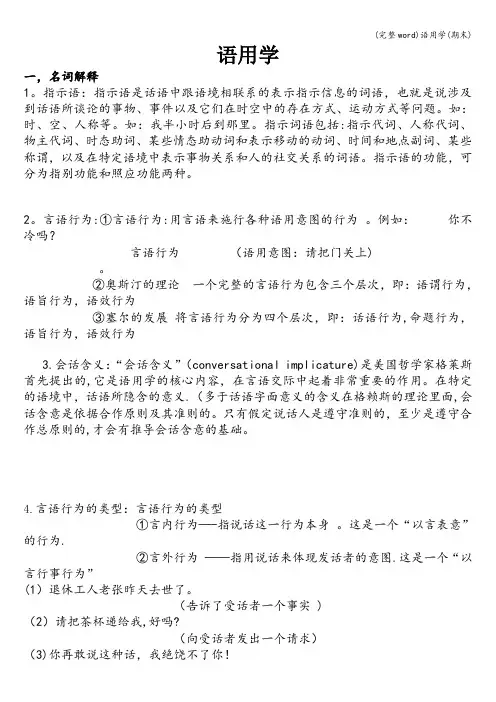
语用学一,名词解释1。
指示语:指示语是话语中跟语境相联系的表示指示信息的词语,也就是说涉及到话语所谈论的事物、事件以及它们在时空中的存在方式、运动方式等问题。
如:时、空、人称等。
如:我半小时后到那里。
指示词语包括:指示代词、人称代词、物主代词、时态助词、某些情态助动词和表示移动的动词、时间和地点副词、某些称谓,以及在特定语境中表示事物关系和人的社交关系的词语。
指示语的功能,可分为指别功能和照应功能两种。
2。
言语行为:①言语行为:用言语来施行各种语用意图的行为。
例如:你不冷吗?言语行为(语用意图:请把门关上)。
②奥斯汀的理论一个完整的言语行为包含三个层次,即:语谓行为,语旨行为,语效行为③塞尔的发展将言语行为分为四个层次,即:话语行为,命题行为,语旨行为,语效行为3.会话含义:“会话含义”(conversational implicature)是美国哲学家格莱斯首先提出的,它是语用学的核心内容,在言语交际中起着非常重要的作用。
在特定的语境中,话语所隐含的意义.(多于话语字面意义的含义在格赖斯的理论里面,会话含意是依据合作原则及其准则的。
只有假定说话人是遵守准则的,至少是遵守合作总原则的,才会有推导会话含意的基础。
4.言语行为的类型:言语行为的类型①言内行为—-指说话这一行为本身。
这是一个“以言表意”的行为.②言外行为——指用说话来体现发话者的意图.这是一个“以言行事行为”(1)退休工人老张昨天去世了。
(告诉了受话者一个事实 )(2)请把茶杯递给我,好吗?(向受话者发出一个请求)(3)你再敢说这种话,我绝饶不了你!(警告或威胁了受话者)(4)对不起,我来晚了. (向受话者道了歉)③言后行为-—指话语所带来的后果.这是一个“以言取效”的行为。
例如:(1)我明天会来的.(2)哥哥,你不要这样。
人家是好心好意来安慰我们. (《雷雨》)5会话原则:美国哲学家保罗。
格赖斯提出的会话原则旨在解释会话意义。
他提出自然语言有其独特的逻辑关系。
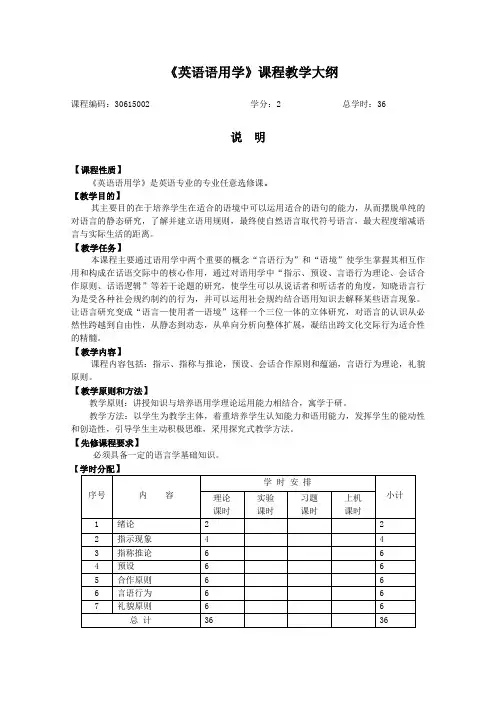
《英语语用学》课程教学大纲课程编码:30615002 学分:2 总学时:36说明【课程性质】《英语语用学》是英语专业的专业任意选修课。
【教学目的】其主要目的在于培养学生在适合的语境中可以运用适合的语句的能力,从而摆脱单纯的对语言的静态研究,了解并建立语用规则,最终使自然语言取代符号语言,最大程度缩减语言与实际生活的距离。
【教学任务】本课程主要通过语用学中两个重要的概念“言语行为”和“语境”使学生掌握其相互作用和构成在话语交际中的核心作用,通过对语用学中“指示、预设、言语行为理论、会话合作原则、话语逻辑”等若干论题的研究,使学生可以从说话者和听话者的角度,知晓语言行为是受各种社会规约制约的行为,并可以运用社会规约结合语用知识去解释某些语言现象。
让语言研究变成“语言—使用者—语境”这样一个三位一体的立体研究,对语言的认识从必然性跨越到自由性,从静态到动态,从单向分析向整体扩展,凝结出跨文化交际行为适合性的精髓。
【教学内容】课程内容包括:指示、指称与推论,预设、会话合作原则和蕴涵,言语行为理论,礼貌原则。
【教学原则和方法】教学原则:讲授知识与培养语用学理论运用能力相结合,寓学于研。
教学方法:以学生为教学主体,着重培养学生认知能力和语用能力,发挥学生的能动性和创造性,引导学生主动积极思维,采用探究式教学方法。
【先修课程要求】必须具备一定的语言学基础知识。
【教材与主要参考书】教材:Yule, George 《语用学》上海外语教育出版社, 2000年。
参考书:何兆熊《新编语用学概要》上海外语教育出版社,2002年。
Verschueren,Jef 《语用学新解》语教学与研究出版社,2003年。
Jaszczolt,K.M. 《语义学与语用学》北京大学出版社,2006年。
大纲内容第一部分绪论【教学目的和要求】教学目的:使学生了解语用学的起源和发展,并初步了解语用学中的几个基本概念及语用学同其它交叉学科的关系与学习意义。

1、语用学术语的提出:1938年,美国哲学家莫里斯首先提出。
符号学包括句法学(研究符号和语义之间的形式关系)、语义学(研究符号与其对象的关系)、语用学(研究符号与解释者的关系)。
2、语用学的发展:1)语言哲学家巴尔—希勒尔于1954年提出语用学的具体研究对象是指引词语。
2)英国哲学家奥斯汀于1955年在哈佛大学做了题为《论言有所为》,提出“言语行为理论”。
3)美国语言哲学家格莱斯提出“会话含义理论”以及“合作原则”。
4)1977年,《语用学杂志》在荷兰的阿姆斯特丹正式出版发行,这是语用学作为语言学一门独立的新学科得到承认的标志。
5)1983年出版了语用学的两本优秀教材:列文森《语用学》、利奇《语用学原则》。
6)1986年,国际语用学学会在荷兰成立,并决定把《语用学杂志》作为学术刊物。
3、语用学的定义:语用学研究在不同语境中话语意义的恰当表达和准确理解,寻找并确立使话语意义得以恰当表达和准确理解的基本原则和准则。
4、语用学和语言学其他分支学科的关系:p95、语用学的研究方法:纯语用学、描写语用学、应用语用学。
6、“语境”是波兰人类语言学家马林诺夫斯基提出的。
7、陈望道在1932年出版的《修辞学发凡》中说:“修辞学以适应题旨情境为第一义,不应该是仅仅语辞的修饰,更不应是离开情意的修饰”。
“六何说”:何故、何事、何人、何地、何时、何如。
8、语境是人们运用自然语言进行语言交际的语言环境。
索振羽的划分p219、语境意义是在特定语境条件下,说话人希望传递的交际信息。
10、指示词语的组织形式:(自我—说话人为中心)1)中心人物是说话人;2)中心时间是说话人说话的时间;3)中心地点是说话人说话时所处的地点;4)语篇中心是一句话中说话人当时正说到的部位;5)社交中心是说话人相当于说话对象的社会地位。
11、指示词语的不同用法:1)指示用法:A、身势用法:指示词语只有借助对言语事件的实在的听觉、视觉、触觉才能理解。
B、象征用法:只需要知道言语事件的基本空间参数就可以理解。
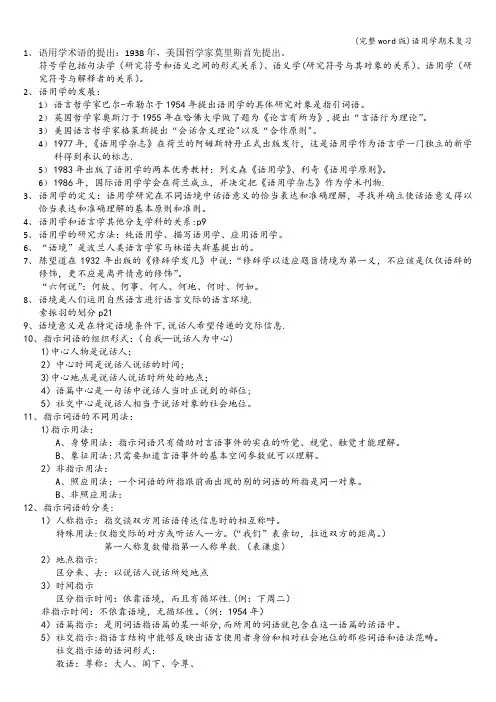
1、语用学术语的提出:1938年,美国哲学家莫里斯首先提出。
符号学包括句法学(研究符号和语义之间的形式关系)、语义学(研究符号与其对象的关系)、语用学(研究符号与解释者的关系)。
2、语用学的发展:1)语言哲学家巴尔-希勒尔于1954年提出语用学的具体研究对象是指引词语。
2)英国哲学家奥斯汀于1955年在哈佛大学做了题为《论言有所为》,提出“言语行为理论”。
3)美国语言哲学家格莱斯提出“会话含义理论"以及“合作原则"。
4)1977年,《语用学杂志》在荷兰的阿姆斯特丹正式出版发行,这是语用学作为语言学一门独立的新学科得到承认的标志.5)1983年出版了语用学的两本优秀教材:列文森《语用学》、利奇《语用学原则》。
6)1986年,国际语用学学会在荷兰成立,并决定把《语用学杂志》作为学术刊物.3、语用学的定义:语用学研究在不同语境中话语意义的恰当表达和准确理解,寻找并确立使话语意义得以恰当表达和准确理解的基本原则和准则。
4、语用学和语言学其他分支学科的关系:p95、语用学的研究方法:纯语用学、描写语用学、应用语用学。
6、“语境”是波兰人类语言学家马林诺夫斯基提出的。
7、陈望道在1932年出版的《修辞学发凡》中说:“修辞学以适应题旨情境为第一义,不应该是仅仅语辞的修饰,更不应是离开情意的修饰”。
“六何说”:何故、何事、何人、何地、何时、何如。
8、语境是人们运用自然语言进行语言交际的语言环境.索振羽的划分p219、语境意义是在特定语境条件下,说话人希望传递的交际信息.10、指示词语的组织形式:(自我—说话人为中心)1)中心人物是说话人;2)中心时间是说话人说话的时间;3)中心地点是说话人说话时所处的地点;4)语篇中心是一句话中说话人当时正说到的部位;5)社交中心是说话人相当于说话对象的社会地位。
11、指示词语的不同用法:1)指示用法:A、身势用法:指示词语只有借助对言语事件的实在的听觉、视觉、触觉才能理解。
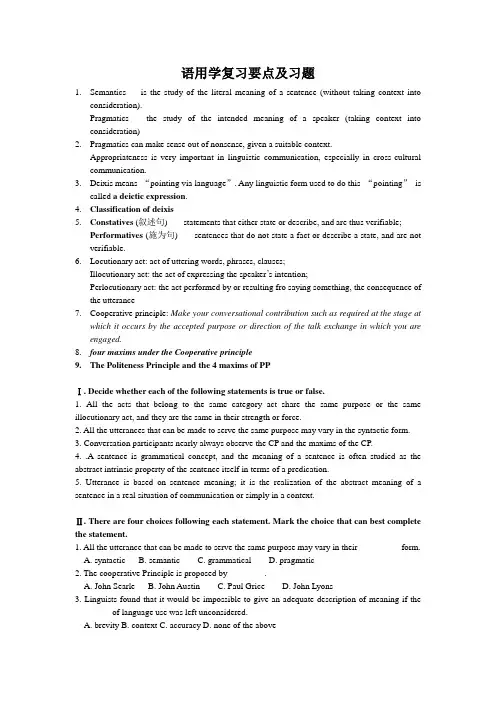
语用学复习要点及习题1.Semantics---- is the study of the literal meaning of a sentence (without taking context intoconsideration).Pragmatics---- the study of the intended meaning of a speaker (taking context into consideration)2.Pragmatics can make sense out of nonsense, given a suitable context.Appropriateness is very important in linguistic communication, especially in cross-cultural communication.3.Deixis means “pointing via language”. Any linguistic form used to do this “pointing”iscalled a deictic expression.4.Classification of deixis5.Constatives (叙述句) ---- statements that either state or describe, and are thus verifiable;Performatives (施为句) ---- sentences that do not state a fact or describe a state, and are not verifiable.6.Locutionary act: act of uttering words, phrases, clauses;Illocutionary act: the act of expressing the speaker’s intention;Perlocutionary act: the act performed by or resulting fro saying something, the consequence of the utterance7.Cooperative principle: Make your conversational contribution such as required at the stage atwhich it occurs by the accepted purpose or direction of the talk exchange in which you are engaged.8.four maxims under the Cooperative principle9.The Politeness Principle and the 4 maxims of PPⅠ. Decide whether each of the following statements is true or false.1. All the acts that belong to the same category act share the same purpose or the same illocutionary act, and they are the same in their strength or force.2. All the utterances that can be made to serve the same purpose may vary in the syntactic form.3. Conversation participants nearly always observe the CP and the maxims of the CP.4. .A sentence is grammatical concept, and the meaning of a sentence is often studied as the abstract intrinsic property of the sentence itself in terms of a predication.5. Utterance is based on sentence meaning; it is the realization of the abstract meaning of a sentence in a real situation of communication or simply in a context.Ⅱ. There are four choices following each statement. Mark the choice that can best complete the statement.1. All the utterance that can be made to serve the same purpose may vary in their _________ form.A. syntacticB. semanticC. grammaticalD. pragmatic2. The cooperative Principle is proposed by ________.A. John SearleB. John AustinC. Paul GriceD. John Lyons3. Linguists found that it would be impossible to give an adequate description of meaning if the ________ of language use was left unconsidered.A. brevityB. contextC. accuracyD. none of the above4. Of the three speech acts, linguistic are most interested in the _________.A. locutionary actB. perlocutionary actC. illocutionary actD. none of the above5. The maxim of quantity requires: ___________.A. make your contribution ad informative as required.B. Do not make contribution more informative than is required.C. Do not say that for which you lack adequate evidence.D. Both A and B6. The maxim of quality requireds: do not say what you believe to be ________.A. falseB. trueC. briefD. orderly7. Most of the violations of the maxims of the CP give rise to _______.A. utterance meaningB. speech act theoryC. conversational implicaturesD. all of the above.8. The significance of Grice’s CP lies in that it explains how it is possible for the speaker to convey _________ is literally said.A. more thanB. less thanC. the same asD. none of the above.Ⅲ. Answer the following question as comprehensively as possible. Give examples for illustration if necessary.1. How does a sentence meaning differ from an utterance meaning?KeyF T F T TA CBCD A C AA sentence meaning is of-ten considered as the intrinsic property of the sentence itself in terms of a predication. It is abstract and independent of context. The meaning of an utterance is concrete, and context-dependent. The utterance meaning is based on sentence meaning; it is realization of the abstract meaning of a sentence in a real situation of communication, or simply in a context. For example, “There is a dog at the door”. The speaker could utter it as a matter-of-fact statement, telling the hearer that the dog is at the door. The speaker could use it as a warning, asking the hearer not to approach the door. There are other possibilities, too. So, the understanding of the utterance meaning of “There is a dog at the door”depends on the context in which it is uttered and the purpose for which the speaker utters it.。
《语用学》复习范围一、绪论1.语用学的由来和发展(“语用学”这个术语的提出;语用学成为新学科的标志);“语用学”(pragmatics拉丁词“行动、做”)这个术语是由美国哲学家莫里斯于1938年在《符号理论基础》一书中首先提出,而哲学家和逻辑学家卡纳普也在其后提出。
莫里斯的符号学包括句法学(符号之间的形式关系),语义学(符号及其所指对象的关系)和语用学(符号和使用者的关系)。
而《语用学杂志》于1977年在荷兰阿姆斯特丹正式出版发行则是语用学成为一门独立的新学科的标志。
1986年,国际语用学学会成立。
2.语用学产生和发展的语言学背景;(索绪尔的语言和语言学理论开创了20世纪的语言学。
受其影响的结构主义语言学派,主张研究语言系统、结构,并尽力追求语言描写形式化。
50年代末,乔母斯基提出转换生成语法理论,使语言分析高度形式化。
从结构主义语言学到转换生成语法,存在两大明显的缺陷,即忽视语言运用研究;语义研究薄弱。
而20C5/60年代,语言系统、结构的研究已经取得了杰出成就,完全具备了重点地研究语言运用的条件和可能性。
而语义研究遇到了难于解决的新问题,为语用学的产生和发展提供了良好的机遇。
)3.语用学的研究内容;语境、指示词语、会话含义、预设、言语行为、会话结构4.语用学和修辞学的区别与联系;●联系:两者的中心问题都是语言运用。
●研究目的不同:修辞学要对语言运用的形式,判别好与不好的界限,注意力是修辞技巧。
而语用学则是解释性的,它的目的是分析语言运用活动,建立意义解释理论,寻找语言运用的规律。
●理论基础不同:修辞学基础薄弱,基本上是一门纯经验的学科,而语用学理论基础雄厚。
●研究方法不同:修辞学主要采纳归纳的方法,而语用学不排斥归纳,但主要方法是理论解释和推理分析。
●研究兴趣和学科传统不同:修辞学以辞格、句子、词语的交际特色、语体风格为具体研究对象;而语用学以语境、指示词语、会话含义等为研究的具体对象。
5.语用学研究的理论意义和实用价值。
语言学概论各章思考题语言学概论各章复习题语言学概论各章思考题第一章语言的社会功能一、什么是“语言”?它和说话是一种什么样的关系?二、如何理解语言在人类社会生活中的重要作用?三、如何理解“语言是人类最重要的交际工具”?四、如何理解语言和思维的关系?五、为什么说语言是思维的最有效的工具?第二章语言是符号系统一、什么是符号?为什么说语言是一种符号?二、语言符号的特点是什么?三、如何理解语言符号的系统性?四、人类语言和动物“语言”的根本区别在哪里?第三章语音一、什么是语音?语音在语言中起着怎样的作用?语音和一般的声音有什么本质区别?二、什么是音质?语音中不同的音质是如何形成的?三、发音原理--语音是怎么发出来的?四、元音和辅音有什么区别?五、元音的音质主要是由什么决定的?元音的发音特征和口腔形状的改变有什么关系?舌位的前后、高低和嘴唇的圆展在元音发音中有什么作用?六、什么是辅音的“发音部位”和“发音方法”?辅音的三对重要发音特点及常见的辅音类别列举。
七、汉语和英语中常见的一些辅音和它们的发音特征。
八、学习和使用国际音标应注意什么问题?九、确立和归纳音位应该遵循哪些原则?十、什么是音位?怎样理解音位的定义?十一、什么是音位变体?怎样理解音位和音位变体的关系?十二、怎样理解音位和音素之间的区别和联系?十三、音位的区别特征和具体的音位系统有怎样的关系?区别特征和音位的聚合的关系是什么?十四、什么是音节?怎样理解音节的形成?十五、汉语普通话音节结构有哪些主要特点?语言学概论各章复习题第四章语法一、语法规则具有怎样的特性?语法的组合规则和聚合规则存在着怎样的联系?二、怎样理解词的定义?怎样把词和语素及词组区别开来?三、构词语素和变词语素有什么不同?四、可以用什么方法判定和区分词的组合的五种基本结构类型?五、什么是语法意义?怎样理解语法意义和语法形式之间的关系?六、怎样理解句法组合的层次性?七、什么是语法结构规则的递归性?递归性和层次性有什么关系?八、词类的划分需要遵循怎样的标准?词类的划分和句法结构的分析和描写有什么关系?九、什么是句法同义?变换和句法同义有怎样的关系?十、什么是句法多义?变换分析对揭示和分化句法多义有怎样的作用?第五章词义一、什么是基本词汇?基本词汇的特点是什么?基本词汇包含的词有哪些重要类型?二、什么是一般词汇?如何区别基本词汇和一般词汇?三、怎样理解词义的概括性?四、什么是多义词和单义词?语言中为什么会有多义词现象?五、词义派生的条件是什么?什么是隐喻和换喻?六、怎样理解同义词现象?怎样辨析同义词?七、反义词有哪两种主要类型?怎样区分反义词的两种类型?八、词义组合有些什么样的特点?第六章文字和书面语一、文字的作用是什么?二、文字是记录语言的书写符合系统。
《语用学》复习提纲本次考试共四种题型:填空题、名词解释、简答题、应用题填空题:(举例如:)(每空1分,共10分)1.语用学源于哲学家对语言的探索。
“语用学”这一术语是由美国哲学家(莫里斯)于1938年首先提出的。
2. 1977年,(《语用学杂志》)在荷兰正式出版发行,“语用学成为语言学的一门独立新兴学科”最终得到认可。
名词解释:(每个4分,共20分)语用学:研究在不同语境中话语意义的恰当地表达和准确地理解,寻找并确立使话语意义得以恰当地表达和准确地理解的基本原则和准则。
语境:语境是人们运用自然语言进行言语交际的言语环境。
语境是人们在语言交际中理解和运用语言所依赖的各种表现为言辞的上下文或不表现为言辞的主观因素。
指示词语:指示词语就是表示指示信息的词语。
?隐性施为句:人们在言语交际中实际上更经常使用一些不那么明确、不那么特定的语言手段来实施某种行为。
优选结构:相邻对中所有可能跟始发语配对的应答语并不具有同等地位,有一组优选结构在起作用,即各种可能的应答语中至少有一类是“合意的”(即听话人的应答能满足说话人发话的期待),有一类是“不合意的”(即听话人的应答不是说话人所期待的)。
预示序列:说话人在以言行事之前用以探听虚实的一类话语。
说话人使用这类话语的主要动机是考察有无向听话人实施某一言语行为的可能性,即说话人实施某一言语行为能否从听话人那里得到“期待的”反应。
会话含义:格赖斯将会话含义分为两类:一般性会话含义和特殊性会话含义。
一般性会话含义:不需要特殊语境就能推导出来的含义。
特殊性会话含义:需要依赖特殊语境才能推导出来的含义。
?直接言语行为:字面意义和说话意图相吻合,也就是句子的结构和功能之间存在着直接的关系。
间接言语行为:人们是通过间接的表达方式实现说话的意图,也可以说句子的结构和功能之间存在着间接的关系分支系列:一种打断某话轮的系列,常由一个相邻对或者“疑问+澄清+结束语”单个话轮的组合形式充当,后者的作用在于提请说话者修正或者重复他正在说的话语。
刘润清《新编语⾔学教程》笔记和课后习题(语⽤学)【圣才出品】第6章语⽤学6.1 复习笔记本章要点:1. Speech act theory⾔语⾏为理论2. Cooperative principle and its maxims合作原则及其准则3. Politeness principle礼貌原则常考考点:语⽤学的定义;语法分析与语⽤学的区别;微观语⽤学中的基本概念;宏观语⽤学中⾔语⾏为理论(发话⾏为、⾏事⾏为和取效⾏为);合作原则;实例分析⾔语⾏为、合作原则的违反和会话含义;礼貌原则。
本章内容索引:I. Pragmatics1. Definition of pragmatics2. Difference between pragmatics analysis and grammatical analysis3. Definition of micropragmatics and macropragmaticsII. Micropragmatics1. Reference2. Deixis3. Anaphora4. PresuppositionIII. Macropragmatics1. Speech Act Theory(1) Theory of the Illocutionary Act①Locutionary act②Illocutionary act③Perlocutionary act(2) Classification of Illocutionary Act①Representatives②Directives③Commissives④Expressives⑤Declarations(3) Indirect speech acts2. The Cooperative Principle (CP)(1) Cooperative Principle and Its Maxims(2) Violation of the Maxims3. Politeness Principle (PP)I. Pragmatics(语⽤学)【考点:名词解释】1. Definition of pragmatics(定义)Pragmatics is the study of speakers’intended meaning, or even the “invisible”meaning, that is, how hearers recognize what is meant even when it isn’t actually said or written.语⽤学是研究语⾔实际运⽤的学科,集中研究说话⼈意义、话语意义或语境意义。
第6章语用学6.1 复习笔记本章要点:1. Speech act theory言语行为理论2. Cooperative principle and its maxims合作原则及其准则3. Politeness principle礼貌原则常考考点:语用学的定义;语法分析与语用学的区别;微观语用学中的基本概念;宏观语用学中言语行为理论(发话行为、行事行为和取效行为);合作原则;实例分析言语行为、合作原则的违反和会话含义;礼貌原则。
本章内容索引:I. Pragmatics1. Definition of pragmatics2. Difference between pragmatics analysis and grammatical analysis3. Definition of micropragmatics and macropragmaticsII. Micropragmatics1. Reference2. Deixis3. Anaphora4. PresuppositionIII. Macropragmatics1. Speech Act Theory(1) Theory of the Illocutionary Act①Locutionary act②Illocutionary act③Perlocutionary act(2) Classification of Illocutionary Act①Representatives②Directives③Commissives④Expressives⑤Declarations(3) Indirect speech acts2. The Cooperative Principle (CP)(1) Cooperative Principle and Its Maxims(2) Violation of the Maxims3. Politeness Principle (PP)I. Pragmatics(语用学)【考点:名词解释】1. Definition of pragmatics(定义)Pragmatics is the study of speakers’intended meaning, or even the “invisible”meaning, that is, how hearers recognize what is meant even when it isn’t actually said or written.语用学是研究语言实际运用的学科,集中研究说话人意义、话语意义或语境意义。
第八章语言的使用复习笔记I.语用学1.定义语用学是研究语言实际运用的学科,集中研究说话人意义、话语意义或语境意义。
2.语用学和语义学的区别虽然语用学和语义学都是研究语言意义的学科,但是它们有着很大的差别:语用学主要研究在特定的语境中说话人所想要表达的意义,而语义学研究的是句子的字面意义,通常不考虑语境。
II.言语行为理论言语行为理论是牛津大学哲学家约翰·奥斯丁在他《如何以言行事》一文中提出的。
它从哲学意义上对语言交际的本质进行解释,其目的在于回答“用语言干什么”这个问题。
1.施为句和叙事句奥斯汀提出自己理论的第一步是把句子分成两类:施为句和叙事句。
它们不能应用于传统的真值判断方法。
因此,他对施为句和叙事句作了区分。
(1)定义施为句是用来做事的,既不陈述事实,也不描述情况,且不能验证其真假;叙事句要么用于陈述,要么用于验证,可以验证其真假。
(2)合适条件虽然施为句没有真假,但必须满足一定条件才是合适的。
我们把奥斯汀的合适条件简化如下:①必须有一个相应的规约程序,并且相关的参与者与环境是合适的。
②该程序必须正确全面地得到执行。
③有关人必须有相关的思想、感情和意图,而且必须有相关的后续行为。
但是奥斯汀很快就认识到,这些条件只适用于部分情况。
2.行事行为理论后来,奥斯汀放弃了他最初对叙事句和施为句所做的区分。
他建立了另一种模式来解释如何通过语言实施行为。
根据这种新的模式,说话人说话时可以完成三种行为:发话行为,行事行为和取效行为。
发话行为是说出词、短语、分句的行为,是通过句法、词汇和音位手段表达字面意义的行为。
行事行为是表达说话人意图的行为,是在说话过程中所完成的行为。
取效行为是通过说话完成或通过说话所产生的行为,是由话语所带来的结果和变化。
在上述三种言语行为中,语言学家最感兴趣的是行事行为,因为这种言语行为与说话人的意图一致。
在研究语言交际时,语言学家最感兴趣的是说话人如何表达他的意图和听话人如何识别说话人的意图。
语用学级期末复习思考题I. Put the following English terms into Chinese. (1'×10=10')所指对象referent所指论Referential theory专有名词 proper name普通名词 common nouns固定的指称记号 rigid designators指称词语deixical items确定性描述语definite descriptions编码时间 coding-time变异性variability表示反复的词语 iterative表述句 constative补救策略redressive strategies不可分离性 non-detachability不确定性indeterminacy不使用补救策略,赤裸裸地公开施行面子威胁行bald on record without redressive actions 阐述类言语行为 representatives承诺类言语行为 commissives指令类言语行为directives表达类言语行为expressives,宣告类言语行为declarations诚意条件 sincerity condition次要言外行为 secondary illocutionary act等级含义 scalar implicature等级划分法 rating scales副语言特征 paralinguistic features非公开施行面子威胁行为 off record非规约性non-conventionality非规约性意义 non-conventional implicature非论证性的 non-demonstrative非自然意义non-natural meaning (meaning-nn)否定测试法negation test符号学 semiotics构成性规则 constitutive rules古典格莱斯会话含义理论 Classical Gricean theory of conversational implicature关联论Relevance Theory关联原则Principle of Relevance归属性用法 attributive use规约性含义conventional implicature人际修辞 interpersonal rhetoric篇章修辞textual rhetoric含蓄动词 implicative verbs合适条件 felicity conditions呼语 vocatives互相显映 mutually manifest会话含义 conversational implicature话语层次策略 utterance-level strategy积极面子positive face间接言语行为 indirect speech acts间接指令 indirect directives结语 upshots交际意图communicative intention可撤销性 cancellability可废弃性 defeasibility可推导性 calculability跨文化语用失误cross-cultural pragmatic failure跨文化语用学cross-cultural pragmatics命题内容条件 propositional content condition面子保全论 Face-saving Theory面子论 Face Theory面子威胁行为 Face Threatening Acts (FTAs)蔑视 flouting明示 ostensive明示-推理模式ostensive-inferential model摹状词理论Descriptions粘合程度 scale of cohesion篇章指示 discourse deixis前提 presupposition前提语 presupposition trigger强加的绝对级别absolute ranking of imposition确定谈话目的 establishing the purpose of the interaction确定言语事件的性质 establishing the nature of the speech event 确定性描述语 definite descriptions认知语用学 cognitive pragmatics上下文 co-text社会语用迁移sociopragmatic transfer社交语用失误 sociopragmatic failure施为句 performative省力原则 the principle of least effort实情动词 factive verbs适从向 direction of fit手势型用法 gestural usage首要言外行为 primary illocutionary act双重或数重语义模糊 pragmatic bivalence/ plurivalence顺应的动态性 dynamics of adaptability顺应性adaptability语境关系的顺应(contextual correlates of adaptability)、语言结构的顺应(structural objects of adaptability)、顺应的动态性(dynamics of adaptability)和顺应过程的意识程度(salience of the adaptation processes)。
说话人经济原则speaker’s economy损-惠等级cost-benefit scale所表达的心理状态 expressed psychological state所指 reference所指对象 referent特殊性会话含义particularized conversational implicature条件性的双重言外行为 conditional bivalent illocutionary act调节性规则 regulative rules投射问题projection problem推理论 inference theory推理模式 inferential model文学语用学 literary pragmatics问卷调查 questionnaire习语论 idiom theory显性施为句 explicit performatives显映 manifest限定语篇长度策略 space-making strategies相对权势 relative power相邻对 adjacency pair象征型用法 symbolic usage小句含义 clausal implicature协商性negotiability新格莱斯会话含义理论Neo-Gricean pragmatic theories of conversational implicature 新格莱斯语用学机制 Neo-Gricean pragmatic apparatus心理表征mental representation信息意图 informative intention行事动词 performative verb宣告类言语行为 declarations言后行为 perlocutionary act言内行为 locutionary act言外行为 illocutionary act言外之的 illocutionary point言外之力 illocutionary force言外之力显示手段 illocutionary force indicating devices (IFIDs)言语事件 speech events言语行为 speech act一般性会话含义 generalized conversational implicature意义 sense因果的、历史的所指论 Causal or Historical Chains Theory隐性施为句 implicit performatives优先结构 preference structure语际语语用学 interlanguage pragmatics语境 context语境关系的顺应contextual correlates of adaptability语码模式 code model语篇标示 discoursal indicator语篇性语用模糊 discoursal ambivalence语言顺应论 Adaptation Theory语言结构的顺应structural objects of adaptability语言能力 linguistic competence语义学semantics语用模糊 pragmatic ambivalence语用能力 pragmatic competence语用迁移 pragmatic transfer语用失误pragmatic failure语用语言迁移 pragmalinguistic transfer语用语言失误 pragmalinguistic failure语用语言学 pragmalinguistics与事实相反的条件句counterfactual conditionals蕴涵、推涵、衍推 entailment期待的第二部分preferred second part预先的元语用评论语 prospective MPCs再表述 reformulations指号 designator指令类言语行为 directives追溯性的元语用评论 retrospective MPCs指示投射 deictic projection指示语/指示性词语 deictic expressions指示性用法 referential use指示中心 deictic center准备条件 preparatory condition着重受话人的元语用评论addressee-oriented metapragmatic comments ( A-MPCs) 着重说话人的元语用评论 speaker-oriented metapragmatic comments (S-MPCs)自然意义 natural meaning自我中心性 egocentricity最大关联 maximal relevance最佳关联 optimal relevance配对比较paired comparison卡片分类card sorting等级划分rating scales开放性面谈open interview引发法elicitationII. Fill in the blanks with a proper word or words. (2'×10=20')1. How did Morris distinguish three aspects of semiotic inquiry?The use of the term is usually attributed to two American philosophers C. Morris and R. Carnap, who first introduced the term ‘pragmatics’ in their study of semioticsin the 1930s. Morris distinguished three aspects of semiotic inquiry, i.e. syntactics (or syntax), being the study of the ‘formal relation of signs to one another’, semantics, the study of the ‘relation of signs to the objects to which the signs are applicable, and pragmatics, the study of ‘the relation of signs to interpreters.’2. What are the two most important notions in Pragmatics?3. How does P. Grice distinguish meanings?The American philosopher P. Grice distinguishes between what he calls natural meaning (meaning-n) and non-natural meaning (meaning-nn). The two terms parallel ‘sentence meaning’ and ‘speaker meaning’.4. What distinction did Frege make in 1952?The German philosopher Frege (1952) is generally credited with the distinction between the reference of a linguistic expression, ‘that to which the sign refers’, and its sense, an interpretation of the sign, provided by the grammar of the language.5. What are the two major philosophical theories about reference?referential theory of names and causal-historical theory6. What are the 2 distinct uses of definite descriptions?K.S. Donnellan (1966:285-286) called attention to what he called the ‘refere ntial use,’ as opposed to the ‘attributive use,’ of a definite description.7. How many types of deictic expressions are there? What are they?Deictic expressions in English are usually classified into five main types: person deixis, spatial deixis, temporal deixis, social deixis, and discourse deixis.8. What are the two different uses of deictic expressions?There are basically two different uses of deictic expressions. They are called gestural usage and symbolic usage respectively.12. What are the two categories of utterances did Austin distinguish?Austin distinguished two categories of utterances, which he referred to respectively as ‘constatives’ and ‘performatives.’9. Who made the greatest contribution to Speech Act Theory in the post-Austinian age?Most of the contributions to Speech Act Theory in the post-Austinian age are ascribed to the American philosopher-linguist John Searle.10. What distinction did Searle make about an utterance?Searle made the distinction between the illocutionary act and the propositional content of an utterance.11. What did IFID stand for?According to Searle, IFID stood for illocutionary force indicating devices.12. What are the two types of rules that govern the linguistic communication according to Searle?Searle distinguishes two basic types of rules, i.e. regulative rules and constitutive rules.13. What are the three most important dimensions of variation in which illocutionary acts differ from one another?Based on his criticism of Austin’s classification, Searle presented his taxonomy of illocutionary acts. He first of all specified 12 dimensions of variation in which illocutionary acts differ from one another. The most important of them are the following three: illocutionary point, direction of fit, and expressed psychological state.14. What are the five types of illocutionary speech acts that identified Searle’s taxonomy?It is mainly based on these three dimensions of difference that Searle builds his taxonomy, which identifies five types of illocutionary speech acts: (1)assertives/representatives,(2) directives,(3) commissives,(4) expressives,(5) declarations.15. What did Jenny Thomas think of indirect language as?Compared with direct language, indirect language is ‘costly and risky.’16. Searle believed that in performing indirect speech acts, there exist two speech acts. What are they?In performing indirect speech acts, two speech acts instead of one are involved,i.e. primary illocutionary act and secondary illocutionary act.17. What is the implied meaning termed in Grice’s theory.The implied meaning is termed conversational implicature in Grice’s theory. 18. What are the most important properties of conversational implicature?Calculability, cancellability or defeasibility, nondetachability, non-conventionality, indeterminacy19. What do Sperber and Wison apply to language understanding?Sperber and Wison apply cognitive psychology and monetary economics to language understanding,20. What are the two models that Ostensive-Inferential Model base on?语码模式(Code Model)和推理模式(Inferential Model)21. What is relevance defined in terms of?Relevance is defined in terms of contextual effect and processing effort.22. What are the most important notions that Relevance Theory focus on?cognition and communication23. What are the most influential ones in the pragmatic studies of politeness?In the pragmatic studies of politeness, the most influential are Leech’s Politeness Principle and Brown & Levinson’s politeness strategies.24. What are the factors that measure the weightiness of a face-threatening act?The weightiness of a face-threatening act is measured by three factors: social distance, relative power and absolute ranking of impositions.25. What are the two aspects of face according to Brown & Levinson?Brown & Levinson define face as the public self-image of an individual, which has two aspects: first positive face, which represents an individual’s desire to be accepted and liked by others; second, there is negative face, which refers to an individu al’s right to freedom of action and his/her need not to be imposed upon by others.26. What are the five sets of politeness strategies put forth by Brown & Levinson?P. 230 bald on record without redressive actions, positive politeness, negative politeness, off record, and Don’t do the FTA.27. What are the three types of meaning in the course of communication?The meaning that is conveyed in the course of communication falls roughly into three types: the asserted meaning, the implied meaning, and the presupposed meaning.28. What’s the way to tell presupposition from entailment?To tell presuppositions from entailments, semanticists proposed the so-called‘negation test’.29. The study of Cross-cultural pragmatics mainly consists of pragmalinguistics, sociopragmatics and interlanguage pragmatics.30. What is pragmatics parameters?Pragmatics parameters refer to those factors that affect the choice of pragmatic strategies, including social distance, power, size of imposition, and rights and obligations. (P. 253)31. The studies of Interlinguage pragmatics include four aspects: pragmatic understanding, language expression, pragmatic transfer and pragmatic failure.32. What cause negative pragmatic transfer?Interlingual interference, Intralingual interference, influence of L1 literacy33. What are the categories of discourse roles?Thomas has distinguished five different categories of producer of talk: Speaker, Author, Reporter, Spokesperson, Mouthpiece; four categories of receivers of talk: Addressee, Audience, Bystander, Eavesdropper.34. What are the types of pragmatic ambivalence?Thomas and Yu Dongming divided pragmatic ambivalence into four major types: 1) Pragmatic multivalence, 2) Pragmatic bivalence/plurivalence, 3) Conditional bivalent illocutionary act, and 4) Discoursal ambivalence.35. Presupposition is associated with some lexical items or certain syntactic structures, which are thus given the name of presupposition triggers. What do you know about them?A large variety of presupposition triggers in English have been identified. They can be found at the lexical, syntactic, and phonological level.Presupposition triggers at the lexical level:1) Definite descriptions, 2) Factive verbs 3) Implicative verbs 4) Change of state verbs 5) Iteratives 6)Verbs of judgingPresupposition triggers at the syntactic level:7)Adverbial clauses and expressions of time 8)Cleft sentences 9)Structures and expressions indicating comparison 10) Non-restrictive attributive clauses 11) Counterfactual conditionals 12) QuestionsPresupposition can also be triggered off by some phonological means such as the shift of the normal sentence stress.36. According to Adaptation Theory, communicative context consists of language users, the mental world, the social world, the physical world, etc.37. According to Adaptation Theory, the reason why people make choices constantly is that language has variability, negotiability and adaptability.38. GU Yueguo thought that in Chinese culture, politeness included four basic elements: repectfulness, modesty, attitudinal warmth, and refinement.39. Generally speaking, pragmatic research includes theoretical exposition and empirical study.40. In empirical study, people usually adopt observational method which is usually divided into two broad categories: quantitative and qualitative.III. Put the following passages into Chinese. (10'×1=10') 分值分布根据两段的长短可能比例有变化,但总分不变。